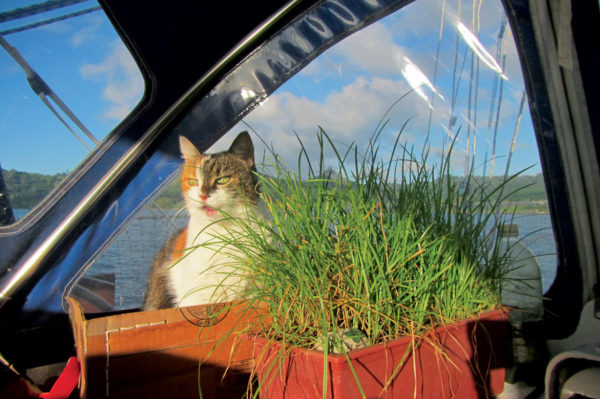
New spray dodgers and biminis keep the cockpit luxuriously dry, however, after a few years of exposure to the elements, especially in the tropics, even high-quality materials start letting some dribble in during strong rainfalls or on rough passages. Of course there are many waterproofing products on the market, but there’s also a low-budget and easy-to-make recipe for DIY waterproofing.
What can be more annoying than having a slow, but constant trickle of water dropping on your head and flowing down your neck while steering the boat through a squall? When the torrential rainfall hits while the boat is anchored the crew can at least seek refuge under deck, but navigational instruments in the cockpit still have to endure the Chinese water torture.
We set out from Croatia in 2011 with a newly made spray dodger and a sun awning, but during a very wet rainy season in Panama the waterproofing on the Sunbrella started getting leaky and the lofty sun awning that had been made for the Mediterranean climate proved inadequate to keep out a proper tropical rainstorm. We therefore bought a few cans of waterproofing spray, put a coat on dodger and awning, before installing a second layer of canvas on top of the awning complete with rollable side parts to collect water and keep the cockpit dry. Such a dry “porch” has the advantage of providing more living room for the crew and also an area for a clothesline to keep damp things from accumulating below deck.
We were happy and dry for a long time, but nothing lasts forever and after a few years the annoying dribbling-game started again. Unfortunately we were at that point out of waterproofing products and far away from chandleries in the remote archipelago of the Tuamotus in French Polynesia, where we were planning to spend another few months. We did not want to cut our stay short, but when the spray dodger started leaking salty drops during a passage into the potted plants that live below it, the situation got serious: our supply of fresh greens was threatened and we had to do something against that incontinent canvas.

In our despair we therefore turned to an old recipe we had heard of long before, but dismissed as too messy: mixing silicone with white spirit. We neither knew the ratio nor how to apply the paste, so we experimented. When we started mixing small amounts of the two components in a cup it looked like they would never unite. After several minutes of stirring we were ready to give up, but slowly the consistency turned to a smooth paste. We tried to apply it with a brush, but it was too thick and coagulated within minutes. Much more white spirit and longer stirring was needed to achieve a rather liquid mixture that was easy to apply—similar to the consistency of an epoxy primer.
During application the canvas gets wet and of course it looks wet, with dark blotches where it has just been treated and lighter areas where it has started drying. That blotchy look disappears as soon as it’s fully dried out after a couple of hours in the sun and the canvas is just as pretty as before. It should still have the chance to fully cure for a day without any rain, so that all the solvent can dissipate while the silicone remains in the material.
We were happy with the look of the result, but would it keep out the rain? During the next downpour we anxiously watched out for leaks, but the rain just formed silvery drops on the Sunbrella that glided gracefully off without soaking the material. Fortunately the result was also rather durable and kept us dry for two years before we had to reapply the magic mixture.
What makes this waterproofing mixture so attractive is that it consists of only two components that most cruising boats carry around in their maintenance locker anyway: transparent silicone and white spirit. The only additional material needed are a mixing cup and a brush. Another advantage is the relatively harmless nature of the chemicals involved. In contrast with many waterproofing sprays no respiratory protection is necessary and once the white spirit has evaporated the canvas smells neutral again.

WATERPROOFING RECIPE:
1 cartridge of transparent silicone
1 bottle of white spirit
1 medium-sized brush
1 mixing pot (min. ½ l)

Unfortunately there’s no fixed ratio for the silicone-white spirit mix. It depends on the kind of silicone, temperature, humidity, etc. Fill your mixing pot 1/3 with silicone, then start adding white spirit in small amounts and stir until you get a homogeneous paste. Gradually add more white spirit while stirring vigorously until you achieve the consistency of paint. The mix has to be liquid enough to thoroughly penetrate the canvas. Add more white spirit and stir again if it starts thickening in the pot while you are still at work.






Hello to Pitufa and crew. I am currently anchored in Hilo Harbour Hawaii practicing social distancing and waiting for the weather to improve to travel home to Canada. This weatherproofing idea seemed like an ideal project. I have tried mineral spirits (which is the white spirit over here) and regular low cost silicone. After mixing for 15 minutes, there was no visible difference and the silicon just whisked around the pot like it had no intention of ever meeting up with that white spirit stuff. I am pretty sure white spirit and mineral spirit are the same, but what kind of silicone did you use? There are several types available.
And a follow up question: have you found any degradation of the canvas threads?
I would love to make this work as waterproofing is very useful in the rainy Pacific Northwest.
Great idea and thanks for posting it,
Brian
Carpe Ventus
Nanaimo, BC, Canada